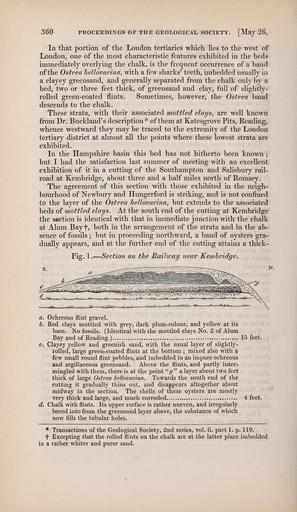MAKE A MEME
View Large Image

| View Original: | The_Quarterly_journal_of_the_Geological_Society_of_London_(13206273444).jpg (1199x2069) | |||
| Download: | Original | Medium | Small | Thumb |
| Courtesy of: | commons.wikimedia.org | More Like This | ||
| Keywords: The Quarterly journal of the Geological Society of London (13206273444).jpg of them at Katesgrove Pits Reading <br> whence westward they may be traced to the extremity of the London <br> tertiary district at almost all the points where these lowest strata are <br> exhibited <br> In the Hampshire basin this bed has not hitherto been known ; <br> but I had the satisfaction last summer of meeting with an excellent <br> exhibition of it in a cutting of the Southampton and Salisbury rail- <br> road at Kembridge about three and a half miles north of Romsey <br> The agreement of this section with those exhibited in the neigh- <br> bourhood of Newbury and Hungerford is striking and is not confined <br> to the layer of the Ostrea bellovacina but extends to the associated <br> beds of mottled clays At the south end of the cutting at Kembridge <br> the section is identical with that in immediate junction with the chalk <br> at Alum Bayf both in the arrangement of the strata and in the ab- <br> sence of fossils ; but in proceeding northward a band of oysters gra- <br> dually appears and at the further end of the cutting attains a thick- <br> Fig 1 ” Section on the Railway near Kembridge <br> a Ochreous flint gravel <br> b Red clays mottled with grey dark pluni-colour and yellow at its <br> base No fossils Identical with the mottled clays No 2 of Alum <br> Bay and of Reading 15 feet <br> c Clayey yellow and greenish sand with the usual layer of slightly- <br> rolled large green-coated flints at the bottom ; mixed also with a <br> few small round flint pebbles and imbedded in an impure ochreous <br> and argillaceous greensand Above the flints and partly inter- <br> mingled with them there is at the point y a layer about two feet <br> thick of large Ostrea bellovacina Towards the south end of the <br> cutting it gradually thins out and disappears altogether about <br> midway in the section The shells of these oysters are mostly <br> very thick and large and much corroded 4 feet <br> d Chalk with flints Its upper sm'face is rather uneven and irregularly <br> bored into from the greensand layer above the substance of which <br> now fills the tubular holes <br> Transactions of the Geological Society 2nd series vol ii part 1 p 119 <br> t Excepting that the rolled flints on the chalk are at the latter place imbedded <br> in a rather whiter and purer sand 36933121 113687 51125 Page 360 Text v 3 http //www biodiversitylibrary org/page/36933121 1847 Geological Society of London NameFound Ostrea NameConfirmed Ostrea EOLID 10719983 NameBankID 2692450 NameFound Ostrea bellovacina NameConfirmed Ostrea bellovacina NameBankID 6681406 Biodiversity Heritage Library The Quarterly journal of the Geological Society of London v 3 1847 Geology Periodicals Smithsonian Libraries bhl page 36933121 dc identifier http //biodiversitylibrary org/page/36933121 smithsonian libraries Information field Flickr posted date ISOdate 2014-03-17 Check categories 2015 August 26 CC-BY-2 0 BioDivLibrary https //flickr com/photos/61021753 N02/13206273444 2015-08-26 12 51 41 cc-by-2 0 PD-old-70-1923 The Quarterly journal of the Geological Society of London 1847 Photos uploaded from Flickr by Fæ using a script | ||||